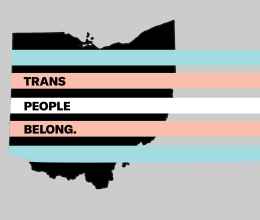In the wake of the passage and implementation of Senate Bill 104, an anti-trans bathroom bill requiring individuals in primary and secondary schools, as well as institutions of higher education to use restrooms and other facilities that align with their sex assigned at birth – and the gerrymandered realities of the Ohio state legislature – local work and reforms are more important than ever. One great example of such a reform is advocating for municipalities to make all public single-occupancy bathrooms gender neutral. Single-occupancy bathrooms are defined as a bathroom that has no more than one toilet, one sink, a urinal, and a door that locks.
Single-occupancy bathroom ordinances ensure that public facilities are safe and accessible for trans and gender-nonconforming people. They also benefit people with disabilities, who may require the assistance of an aid or caretaker in the restroom; caretakers and parents, who need to accompany young children to the restroom; and anyone who has waited in line for a single-stall gendered restroom when a single-stall restroom marked for another gender was unoccupied. I have been asked to bring young girls into the women’s restroom with me because they were out in public with their father or brother and there were no family or gender-neutral restrooms available; this is not a unique experience.
Single-occupancy restroom ordinances are not a new or radical idea. Cities across the country have implemented these policies including Austin in 2014 and Atlanta in 2021. Here in Ohio, Cincinnati City Council unanimously passed a single-occupancy restroom ordinance in September of 2021. These ordinances are not only common sense, but they are also explicitly allowed under Ohio law. This policy complies with Ohio Building Code, including Section 2902.1.2, which says: "Single-user toilet and bathing rooms, and family or assisted-use toilet rooms and bathing rooms shall be identified as being available for use for use by all persons regardless of their sex.” SB 104 explicitly allows for single-occupancy restrooms to be gender-neutral as well, which illustrates how non-politicized this issue is.
In a listening survey done by the ACLU of Ohio’s Action Team at Southwest Ohio Pride Festivals last summer, 24% of respondents said that the top way their city could better protect LGBTQ+ people was more visible representation. Passing a single-occupancy bathroom ordinance is a simple but powerful way for Ohio municipalities and local leaders across the state to show their support for LGBTQ community members, while also making a positive impact on the daily lives of all their residents.
The ACLU of Ohio is working in coalition with organizations across the state to advance proactive, local policies that promote LGBTQ+ equality.







